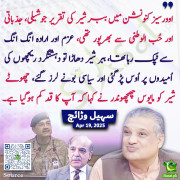Asad Mujtaba
Chief Minister (5k+ posts)
Summary of the Hamoodur Rahman Commission Report

The Hamoodur Rahman Commission Report was an investigation conducted by the Pakistani government to understand the reasons behind the surrender of the Pakistani Armed Forces in East Pakistan (now Bangladesh) in 1971. Here are the key points and findings from the report:
Objectives and Methodology
• Purpose: To investigate the circumstances leading to the surrender of the Eastern Command and the subsequent fall of East Pakistan.
• Process: The commission examined 213 witnesses initially and later reactivated to incorporate testimonies of repatriated prisoners of war and civil personnel. They held further inquiries, scrutinizing 72 more witnesses, including senior military and civilian officers.
Key Findings
1. Military and Moral Failures: The commission found significant moral and professional failures among senior military officers. Corruption, moral degradation, and incompetence were highlighted as critical issues.
• Martial Law Impact: The involvement in civil administration and martial law duties since 1958 had corrupted senior officers, leading to widespread immorality and inefficiency.
• Specific Officers: Lt. Gen. A.A.K. Niazi was particularly noted for his immoral conduct and involvement in smuggling. His behavior was said to have set a negative example for other officers and soldiers.
2. Military Operations and Atrocities:
• Excessive Force: The Pakistani Army’s initial operations on March 25-26, 1971, were marked by excessive use of force. Later operations involved wanton arson and killings, particularly during “sweep operations.”
• Specific Incidents: The report cites the massacre at Comilla Cantt. and the widespread looting and killing by certain military units.
• Rape and Killings: The commission acknowledged allegations of rape and killings of intellectuals and civilians by the Pakistani military, although it also noted that some allegations might be exaggerated.
3. Political and Administrative Failures:
• Poor Civil-Military Relations: The civil administration was almost entirely bypassed, with the military assuming full control, often leading to poor decision-making and abuses.
• Failures of Leadership: Both military and civilian leaders failed to maintain discipline and control, contributing to the breakdown of order and eventual surrender.
4. Recommendations:
• Further Inquiries and Trials: The commission recommended further inquiries and trials for those responsible for atrocities and failures. It emphasized the need for accountability to restore the integrity and discipline of the armed forces.
• Military Reforms: Recommendations for extensive military reforms were made to prevent such failures in the future.
Supplementary Report
• The supplementary report, created after the repatriation of prisoners, confirmed most of the initial findings and provided additional evidence, reinforcing the conclusions drawn in the main report.
Conclusion
The Hamoodur Rahman Commission Report painted a grim picture of the state of the Pakistani military and its leadership during the 1971 conflict. It highlighted moral and professional failings, poor leadership, and the need for substantial reforms and accountability to prevent a recurrence of such a national disaster.
https://twitter.com/x/status/1798030356756746273
The Hamoodur Rahman Commission Report was an investigation conducted by the Pakistani government to understand the reasons behind the surrender of the Pakistani Armed Forces in East Pakistan (now Bangladesh) in 1971. Here are the key points and findings from the report:
Objectives and Methodology
• Purpose: To investigate the circumstances leading to the surrender of the Eastern Command and the subsequent fall of East Pakistan.
• Process: The commission examined 213 witnesses initially and later reactivated to incorporate testimonies of repatriated prisoners of war and civil personnel. They held further inquiries, scrutinizing 72 more witnesses, including senior military and civilian officers.
Key Findings
1. Military and Moral Failures: The commission found significant moral and professional failures among senior military officers. Corruption, moral degradation, and incompetence were highlighted as critical issues.
• Martial Law Impact: The involvement in civil administration and martial law duties since 1958 had corrupted senior officers, leading to widespread immorality and inefficiency.
• Specific Officers: Lt. Gen. A.A.K. Niazi was particularly noted for his immoral conduct and involvement in smuggling. His behavior was said to have set a negative example for other officers and soldiers.
2. Military Operations and Atrocities:
• Excessive Force: The Pakistani Army’s initial operations on March 25-26, 1971, were marked by excessive use of force. Later operations involved wanton arson and killings, particularly during “sweep operations.”
• Specific Incidents: The report cites the massacre at Comilla Cantt. and the widespread looting and killing by certain military units.
• Rape and Killings: The commission acknowledged allegations of rape and killings of intellectuals and civilians by the Pakistani military, although it also noted that some allegations might be exaggerated.
3. Political and Administrative Failures:
• Poor Civil-Military Relations: The civil administration was almost entirely bypassed, with the military assuming full control, often leading to poor decision-making and abuses.
• Failures of Leadership: Both military and civilian leaders failed to maintain discipline and control, contributing to the breakdown of order and eventual surrender.
4. Recommendations:
• Further Inquiries and Trials: The commission recommended further inquiries and trials for those responsible for atrocities and failures. It emphasized the need for accountability to restore the integrity and discipline of the armed forces.
• Military Reforms: Recommendations for extensive military reforms were made to prevent such failures in the future.
Supplementary Report
• The supplementary report, created after the repatriation of prisoners, confirmed most of the initial findings and provided additional evidence, reinforcing the conclusions drawn in the main report.
Conclusion
The Hamoodur Rahman Commission Report painted a grim picture of the state of the Pakistani military and its leadership during the 1971 conflict. It highlighted moral and professional failings, poor leadership, and the need for substantial reforms and accountability to prevent a recurrence of such a national disaster.
https://twitter.com/x/status/1798030356756746273
Last edited by a moderator:

































